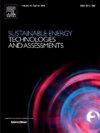Development and performance evaluation of a novel industrial-scale fixed bed dryer for alkali-treated eucheuma cottonii chips
IF 7.1
2区 工程技术
Q1 ENERGY & FUELS
Sustainable Energy Technologies and Assessments
Pub Date : 2025-07-14
DOI:10.1016/j.seta.2025.104453
引用次数: 0
Abstract
Drying alkali-treated Eucheuma cottonii chips (ATCC) in the seaweed industry demands significant resources, particularly energy, and generates substantial CO2 emissions, especially when fossil fuels serve as the primary energy source. Simultaneously, the global seaweed industry has become increasingly competitive, which demands technological advancements across processing stages, especially in drying. Here, we developed a novel industrial-scale fixed-bed dryer (FBD) for ATCC and assessed its feasibility to address these issues. Several critical parameters, including product quality, drying performance, and CO2 emission reduction, were evaluated to determine the novel FBD’s viability compared to a conventional FBD. Drying kinetics were also analyzed using 24 thin-layer drying models to identify the most appropriate model for describing ATCC drying behavior with the novel FBD. The results of this study indicated that the novel FBD effectively dried ATCC to a quality suitable for milling. The Improved Midilli-Kucuk and Hii et al. models provided the best fit for describing the drying kinetics. Additionally, the novel FBD reduced drying time by one hour, decreased specific energy consumption by 60%, improved drying efficiency by over 150%, and lowered drying costs by 55%. Consequently, it emitted 60% less CO2 than the conventional FBD. In conclusion, this study successfully developed a novel FBD that addresses the critical challenges of high energy consumption and CO2 emissions in ATCC drying and also offers multiple benefits for the global seaweed industry, aligning with the objectives of SDG 7, SDG 9, and SDG 13.
新型工业规模碱处理棉麒麟片固定床干燥机的研制及性能评价
在海藻工业中,干燥碱处理的真毛棉片(ATCC)需要大量的资源,特别是能源,并产生大量的二氧化碳排放,特别是当化石燃料作为主要能源时。与此同时,全球海藻行业的竞争日益激烈,这就要求整个加工阶段的技术进步,特别是在干燥方面。在此,我们为ATCC开发了一种新型工业规模的固定床干燥机(FBD),并评估了其解决这些问题的可行性。研究人员对产品质量、干燥性能和二氧化碳减排等几个关键参数进行了评估,以确定与传统FBD相比,新型FBD的可行性。用24个薄层干燥模型分析了干燥动力学,以确定用新型FBD描述ATCC干燥行为的最合适模型。研究结果表明,新型FBD能有效干燥ATCC,使其达到适合制粉的质量。改进的midli - kucuk和Hii等模型最适合描述干燥动力学。此外,新型FBD干燥时间缩短了1小时,比能耗降低了60%,干燥效率提高了150%以上,干燥成本降低了55%。因此,它比传统的FBD少排放60%的二氧化碳。总之,本研究成功开发了一种新型FBD,解决了ATCC干燥过程中高能耗和二氧化碳排放的关键挑战,并为全球海藻行业带来了多重好处,符合可持续发展目标7、9和13。
本文章由计算机程序翻译,如有差异,请以英文原文为准。
求助全文
约1分钟内获得全文
求助全文
来源期刊

Sustainable Energy Technologies and Assessments
Energy-Renewable Energy, Sustainability and the Environment
CiteScore
12.70
自引率
12.50%
发文量
1091
期刊介绍:
Encouraging a transition to a sustainable energy future is imperative for our world. Technologies that enable this shift in various sectors like transportation, heating, and power systems are of utmost importance. Sustainable Energy Technologies and Assessments welcomes papers focusing on a range of aspects and levels of technological advancements in energy generation and utilization. The aim is to reduce the negative environmental impact associated with energy production and consumption, spanning from laboratory experiments to real-world applications in the commercial sector.
 求助内容:
求助内容: 应助结果提醒方式:
应助结果提醒方式:


